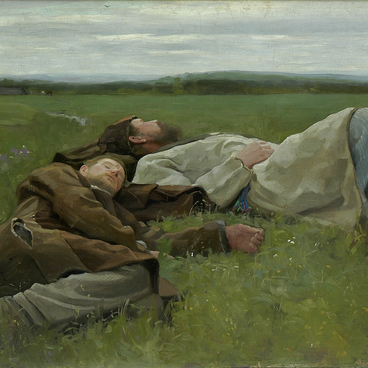Nikolai Prokhorov was born in 1896 into a poor painter’s family from the Kostroma Province. In 1908, the family moved to Orenburg. During the Civil War the would-be artist was drafted into the White Army, he deserted it and joined the Red Army serving in the Caucasus. He later got married and moved to Petrograd (now, St. Petersburg). He studied there under the famous engraver and painter Pavel Shillingovsky at the graphic arts department of the Higher Institute of Art and Technology (VKHUTEIN), the former Academy of Arts.
Self-Portrait
Время создания
The second half of the 1930s
Размер
60x75 cm
Техника
Canvas, oil
Коллекция
Выставка
#3
Nikolai Prokhorov
Self-Portrait
#2
#4
Artist Peter Miturich wrote about Prokhorov in those years:
“He looks bad, it is clear that he is angry due to hunger.”
#5
“Still-life with Boots” of the 1920s demonstrated the Petrograd life of that time: poverty-ridden living in the rooms of a former tenement building concentrated around the metal makeshift stoves. However, the artist worked hard: he drew a lot, studied anatomy, mastered printing from stone and lithography and illustrated books.
In the mid-1920s, Nikolai Prokhorov began to create advertising posters, among them are “Gospromtsvetmet” and “Pischetrest”. Leningrad - Moscow’. They clearly point to the artist’s interest in avant-garde art: the contrasting figures of foodstuffs are next to the abstract color volumes.
#6
The self-portrait from the Orenburg Museum of Fine Arts exposition painted in oil is his only preserved painting. The canvas is painted with large strokes; the confident and clear silhouette line seems to pull the artist out of the space of his studio. The compressed lips, the direct gaze, the wrinkle cutting through the forehead create a feeling of inner tension. It is highlighted by the sharp contrast of the cold medium blue and the warm ochre-brown tones.
In the 1930s, the USSR largest museums, including the Pushkin State Museum of Fine Arts and the Russian Museum purchased Prokhorov’s works; his pieces were displayed at domestic and international exhibitions. During those years, he established himself as a master of wood engraving and xylography (woodcut engraving). ‘The Red Army Soldier’ depicts the proud figure of a Soviet soldier, the ‘Putilov Plant Red Worker’ epitomizes the Soviet production power, while the ‘Storming of the Winter Palace’ portrays a revolutionary collision.
In the 1930s, the USSR largest museums, including the Pushkin State Museum of Fine Arts and the Russian Museum purchased Prokhorov’s works; his pieces were displayed at domestic and international exhibitions. During those years, he established himself as a master of wood engraving and xylography (woodcut engraving). ‘The Red Army Soldier’ depicts the proud figure of a Soviet soldier, the ‘Putilov Plant Red Worker’ epitomizes the Soviet production power, while the ‘Storming of the Winter Palace’ portrays a revolutionary collision.
#7
However, in 1935 the artist became subject of the repression and was ordered to leave Leningrad (now, St. Petersburg). No precise information about the charges brought against him is available. According to one version, the NKVD (secret police) men even came to the railway station to assure Prokhorov and his wife that it was a mistake and he was under no obligation to leave; the artist, however, decided to return to Orenburg.
In the final years of his life, Prokhorov worked as a book and newspaper designer, creating a series of works on the visits to the Orenburg Region of Vladimir Dahl and Alexander Pushkin, the poet. At that period of time he also painted watercolors of the pre-war Orenburg landscapes, for example, ‘The Courtyard with a Ladder’ and ‘At the Orenburg Market’. In 1941, the artist went to the front; he got wounded 80 km from Stalingrad and died in a military hospital.
#8
Orenburg Regional Museum of Fine Arts
читать дальшескрыть
00:00
00:00
1x
Self-Portrait
Время создания
The second half of the 1930s
Размер
60x75 cm
Техника
Canvas, oil
Коллекция
Выставка
Открыть в приложении
Поделиться



